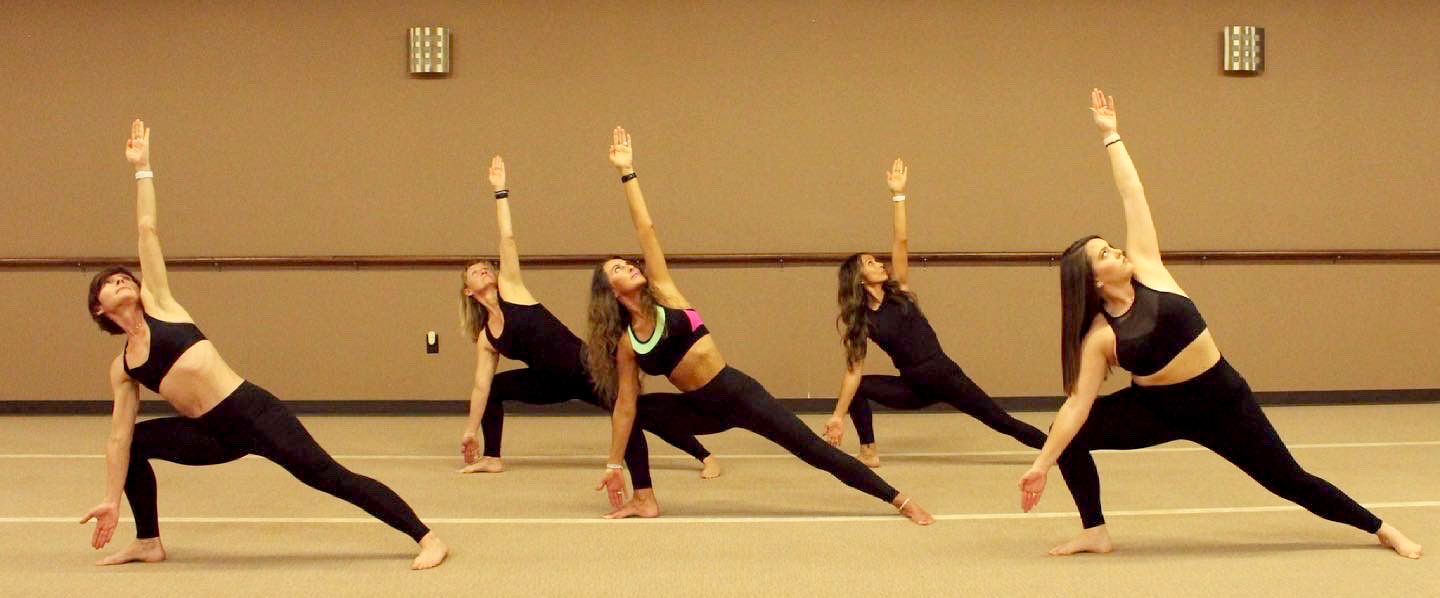
Bikram Yoga is the practice of 26 postures that were hand-picked by Bikram Choudhury and placed in a specific order, for maximum health benefits. These postures were taken from the original 84 classic hatha yoga postures that Bikram studied under his guru, Bishnu Gosh, in Calcutta, India. The series is bookended by two breathing exercises.
It has been proved and experienced by millions that these 26 postures systematically work every part of the body, to give all the internal organs, all the veins, all the ligaments, and all the muscles everything they need to maintain optimum health and maximum function. Each component takes care of something different in the body, and yet they all work together synergistically, contributing to the success of every other one, and extending its benefits.
Twenty-Six Postures & Two Breathing Exercises:
Pranayama Breathing (Standing Deep Breathing)
• Good for the lungs and respiratory system
• Helps lungs reach their maximum expansion capacity
• Alleviates and prevents asthma, shortness of breath and nervousness
• Oxygenates the blood, to increase the efficacy of all the following postures
1) Ardha-Chandrasana (Half-Moon Pose)
• Heats up the body and starts the cardiovascular work
• Stretches the spine in all four directions, waking up the central nervous system and loosening muscles throughout the body
• Builds muscles that support the spine and opens the hips and shoulders, improving posture and skeletal alignment and relieving chronic back pain
• Trims and shapes the waist-line
2) Pada-Hastasana (Hands to Feet)
• Improves flexibility and restores elasticity of the spine
• Aids in the flow of blood to the brain
• Stretches entire backside of body, especially muscles and ligaments of the legs (hamstrings) and lower back
3) Utkatasana (Awkward Pose)
• Strengthens major muscle groups in the body: arms, legs, stomach, back and heart
• Builds proper alignment in the knees, ankles, hips, and shoulders
• Develops tremendous concentration and strength of will
4) Garurasana (Eagle Pose)
• Improves mobility in the pelvic girdle and all 14 major joints (ankles, knees, hips, shoulders, scapulae, elbows and wrists)
• Increases circulation to the heart and lungs, digestive system and sexual organs
• Flushes the lymph nodes, boosting the immune system
• Stimulates the transfer of serum calcium into the bones, preventing osteoperosis
5) Dandayamana-Janushirasana (Standing Head to Knee Pose)
• Develops concentration, determination, patience and balance
• Strengthens legs and abdomen
• Increases the flexibility of the hamstrings, sciatic nerves and lower back
6) Dandayamana-Dhanurasana (Standing Bow Pulling Pose)
• Increases circulation to the heart and lungs
• Improves elasticity of the spine, hips and legs
• Promotes grace and willpower and cultivates a strong mind-body connection
7) Tuladandasana (Balancing Stick Pose)
• Increases blood flow throughout the body
• Clears blockages in arteries, and is preventative against future cardiac problems
• Reduces and prevents varicose veins
• Builds strength in legs, arms and back
8) Dandayamana-Bibhaktapada Paschimotthanasana (Standing Separate Leg Stretching Pose)
• Releases tension in the lower back muscles and stretches the backs of the legs
• Strengthens the diaphragm, biceps, triceps, and quadriceps
• Improves overall brain function and creates emotional stability by increasing circulation to the brain
9) Trikanasana (Triangle Pose)
• Builds strength in the arms and legs
• Creates flexibility in the hips and shoulders
• Forces the lungs and heart to work in synchrony
• Increases the heart-rate, promoting cardiovascular strength and preparing the body for the following posture
10) Dandayamana-Bibhaktapada Janushirasana (Standing Separate Leg Head to Knee Pose)
• Balances the metabolism by increasing para-thyroid function
• Flushes the lymph nodes in the throat
• Compresses the pancreas and stretches the kidneys, balancing hormone production in the body
• Improves spinal flexibility
11) Tadasana (Tree Pose)
• Stretches and aligns the hips
• Promotes focus and balance
• Trains the body to stand correctly
12) Padangustasana (Toe Stand Pose)
• Builds concentration, patience, balance and focus
• Stretches and aligns the hips and feet
• Promotes strength in the abdomen and back
13) Savasana (Dead Body Pose)
• Optimizes the circulation of freshly oxygenated blood to the entire body
• Cultivates relaxation in the whole body
• Calms and centers the mind
• Brings the body into a natural state of balance – including blood pressure, respiratory rate and brain waves
14) Pavanamuktasana (Wind Removing Pose)
• Cures and prevents flatulence and relieves most chronic abdominal discomforts
• Improves flexibility of hip joints
• Strengthens biceps and muscles that innervate the fingers
• Lengthens the spine and promotes skeletal alignment
Sit Up
• Creates abdominal strength
• Increases flexibility in the legs and back
• Expels metabolic wastes that accumulate in the lungs during exercise
15) Bhujangasana (Cobra Pose)
• Strengthens the lower back
• Promotes circulation and proper alignment in the back and abdomen, alleviating symptoms of PMS and aiding digestion
• Develops precise body awareness
• Prevents and cures back pain and herniated vertebral discs
16) Salabasana (Locust Pose)
• Reverses common issues related to repetitive stress in the forearms, hands and elbows
• Increases circulation in the legs, preventing and curing varicose veins
• Prevents and cures back pain
• Increases back strength, especially around the upper spine
17) Poorna-Salabasana (Full Locust Pose)
• Tones and strengthens the entire back, with an emphasis in the thoracic region
• Builds will and determination
• Increases circulation to the spine and improves functioning of the nervous system
• Prevents and cures back pain
18) Dhanurasana (Bow Pose)
• Creates mobility in the spine, hips and shoulders
• Balances digestive enzymes, curing appetite problems (over-eating and under-eating)
• Improves circulation to the uterus, preventing and curing menstrual problems and improving fertility
• Prevents and cures back pain
19) Supta-Vajrasana (Fixed Firm Pose)
• Increases circulation to the hips, knees and feet, eliminating tight areas and healing injuries
• Improves functioning of the spleen, boosting the immune system
• Creates flexibility in the chest and shoulders
20) Ardha-Kurmasana (Half Tortoise Pose)
• Increases blood flow to the brain improving memory and mental clarity
• Increases flexibility of the hip joints and muscles of the shoulder joints
• Relieves neck and shoulder tension, lower back pain, and firms abdomen
21) Ustrasana (Camel Pose)
• Creates maximum compression of the spine, which stimulates the nervous system
• Stretches the entire front side of the body, including the heart and throat
• Prevents and cures back pain
• Creates flexibility in the chest and shoulders, preventing and curing kyphosis
22) Sasangasana (Rabbit Pose) Spinal Flexibility
• Creates space between vertebrae, improving function of the nervous system
• Increases circulation to the brain, preventing and curing mood disorders, sleep disorders and some respiratory problems
• Relieves tension in neck, shoulder and back muscles
23) Janushirasana (Head to Knee)
• Stretches the whole back of the body, including the hips, hamstrings, achilles tendons and the lower back
• Promotes the circulation of lymph, boosting the immune system
• Increases circulation to the liver, spleen, pancreas, thyroid, thymus and intestines
24) Paschimotthanasana (Stretching Pose)
• Increases flexibility in the hamstrings, alleviating and preventing lower back pain
• Creates space between vertebrae, preventing and rehabilitating herniated discs
• Strengthens the biceps and quadriceps
25) Ardha-Matsyendrasana (Spine Twisting Pose)
• Realigns the vertebral column, alleviating problems like scoliosis, kyphosis, and lordosis
• Increases circulation to the spinal nerves, veins and tissues
• Calms the nervous system
26) Vajrasana (Firm Pose)
• Creates flexibility and helps alignment of the knees and ankles
• Promotes good posture in the spine
• Prepares the body and mind for a meditative state
Kapalbhati (Blowing)
• Removes residual air from the lungs, expelling toxins and lactic acid that stretching has freed from the muscles during class
• Stimulates circulation to the digestive system
• Strengthens the abdominal muscles and trims the waistline

